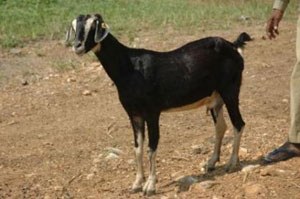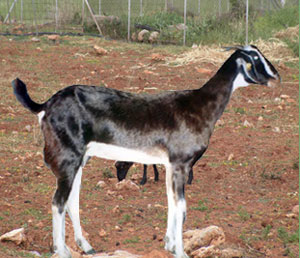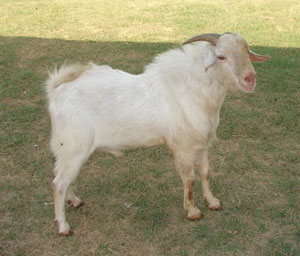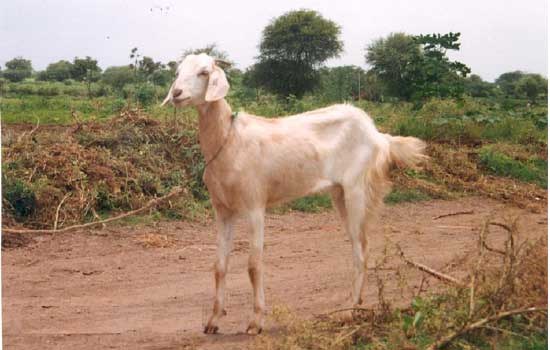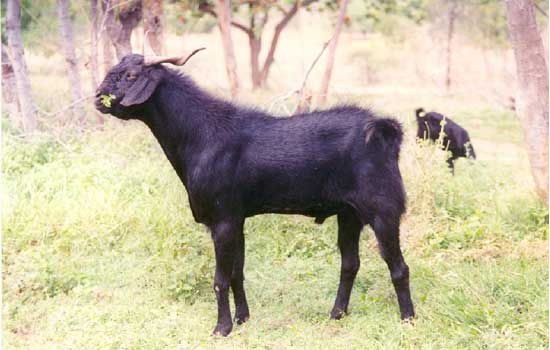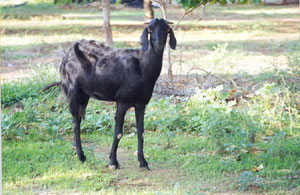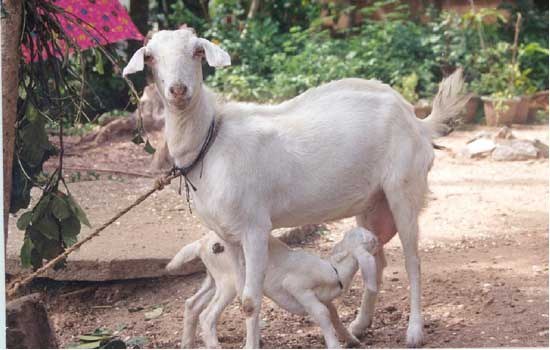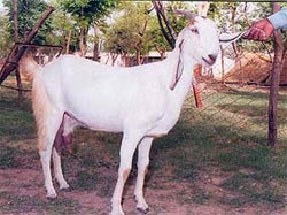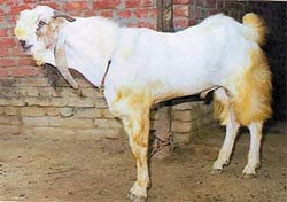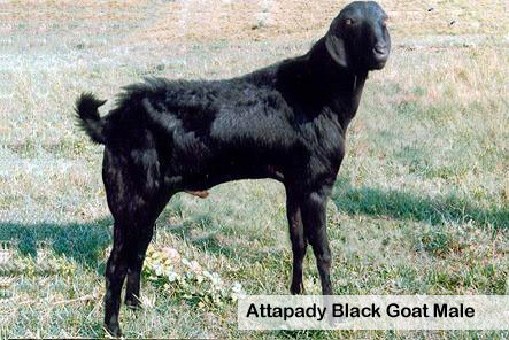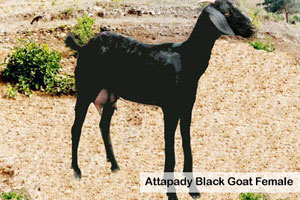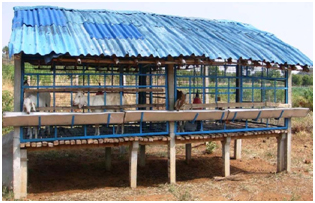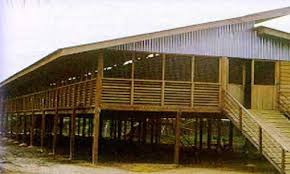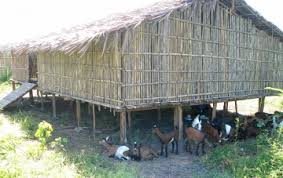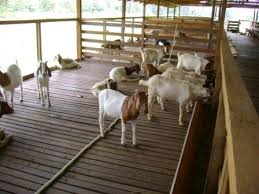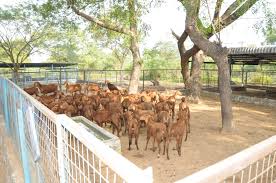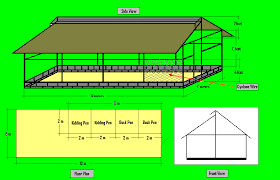Goats have been considered as poor man’s goat(mini goat)
because of it’s immense contribution in rural economy. Goat
has been reared since the time immemorial. Goat keeping
provides source of regular income to the poor, landless and
marginal farmers. Generally goat farming means rearing goats
for the purpose of harvesting milk, meat and fibre. Goat
farming has become a profitable business and it requires a
very low investment.
Goat meat is a great source of consumable meat which is very
testy, nutritious and healthy. And goat’s wool is being used
in many purposes and skin of goat plays a vital role in
leather industry. Goat milk is easily digestible and has
medicinal values. Goats are called the “foster mother of
human? Because their milk is considered as the best milk for
human consumption than any other species of livestock animal’s
milk. And their milk is low cost, nutritious, wholesome and
easily digestible. All aged people from child to old one can
easily digest goat’s milk. Goat milk also has lesser allergic
problems. There are many advantages of goat farming business.
You can also raise goats along with your other livestock
animals. As goats are small sized animal, so they are easily
maintained. Even they are easily maintained and cared by women
and children.
-
Starting
a goat farming business requires low initial investment or
capital.
-
Goats
don’t require huge area for housing because their body size
is comparatively smaller than other livestock animals.
-
Usually
goats are very friendly in nature and very lovable.
-
Goats
are good breeders and they reach sexual maturity within
their 7-12 months of age and give birth of kids within a
short time. And some goat breed produce numerous kids per
kidding.
-
Risks
are less for goat farming (even in drought prone areas) than
any other livestock farming business.
-
Both
male and female goats have almost equal value/price in the
market.
-
No
religious taboo against goat farming and meat consumption.
-
There
is no need of a high end housing system for goats. Even they
can easily share their living place with their owners or
his/her other livestock animals.
-
Diseases
are less in goats than other domestic animals.
-
Goats
are easily available, comparatively cheaper in price, easy
to maintain
-
They
are capable of adopting themselves with almost all types of
agro climatic environments or conditions. They can tolerate
high and low temperature throughout the world. They also can
tolerate hot climate more than other animals.
-
According
to the investment per unit they produce more than other
domestic animals. And the ROI (return of investment) ratio
is very good.
-
Goat
meat has a huge demand and high price in the local and
international markets. Goats can be milked as often as
required
-
You
can use the goat’s manure as a high quality natural
fertilizer in crop field.
-
Commercial
goat farming business is a great source of employment and
income. So unemployed educated people can easily create a
great employment and income source through raising goats
commercially.
Breeds
of Goat suitable for Konkan region
Konkan Kanyal
-
They are native to the Konkan region of Maharashtra, and are reared mostly by the Dhangar and Maratha communities for meat.
-
These goats are mainly black with a white marking in a
specific pattern–the ventral surface of the body is white and the legs have white ‘stockings? Konkan Kanyal goats have bilateral white strips from nostrils to ears; a flat and broad forehead; flat, long drooping ears; backward, straight,
pointed, cylindrical horns; white muzzle and long legs, laterally black, medially white from knee to the fetlock joint.
-
The body weight of adult bucks and does averages 35 and 30 kg
respectively. Konkan Kanyal goats are regular breeders and
breed round the year, with a twinning percentage of about 66%.
Konkan Kanyal goat
Sangamneri
·
The semi
arid region of Maharashtra comprising of Nasik, Ahmednagar and
Pune districts forms the native habitat of the Sangamneri goat
breed.
·
The breed
derives its name from the Sangamner Tehsil of Ahmednagar
District. They are medium-sized animals. The coat is
completely white with mixtures of black and brown. Ears are
long and drooping. Both sexes have horns directed backward and
upward. The litter size is mainly single however 15 ?20%
goats show twinning whereas triplets are rare.
·
The
average daily milk yield varies between 0.5 to 1.0 kg with an
average lactation length of about 160 days. Although this
breed is reared mainly for meat, some animals show a good
milch potential. Dressing percentage is about 41% at 6 months,
45% at 9 months and 46% at 12 months of age.
Adult Male
Adult Female
Average Body weight
(kg) 39 to 42 32 to 34
Average Body length
(cm) 73 to 75 68
Average Height at
withers (cm) 74 to 76 69
Average Chest girth
(cm) 73 to 76 73
Sangamneri breed buck and doe
Osmanabadi
·
Osmanabadi goats are native to the Latur, Tuljapur and
Udgir taluks of Osmanabad district of Maharashtra, from
where they derive their name. They are also fairly
widespread in Karnataka, and the Nizamabad district of
Andhra Pradesh.
·
The
goats are large in size. The colour of the coat varies,
but is mostly black (73%), with the rest being white,
brown or spotted. Ninety per cent males are horned;
females may be horned or polled.
·
The
breed is considered useful both for meat and milk.
Average daily milk yield varies from 0.5 to 1.5 kg for a
lactation length of about 4 months. In favourable
conditions they breed regularly twice a year and twinning
is common.
Adult Male
Adult Female
Average Body
weight (kg)
31 to 36
32 to 33
Average Body
length (cm)
67
to 71 67
Average Height at
withers (cm)
76 to 79
75
Average Chest girth (cm)
70 to 74 72
Osmanabadi
buck and doe
Malabari
-
Malabari also known as Tellicherry or Cutch are native to
Kerala.
-
Malabari goats are reared for milk and meat and their
skin is popular in the tanning industry.
-
The
animals are medium in size. They have no uniform colour
and the coat varies from completely white to black.
-
All
males and a small number of females are bearded. They
have a medium sized head with a flat and occasionally a
Roman nose with medium sized ears directed outward and
downward.
-
Malabari goats are reared under a semi-intensive
management system, with 4 to 6 hours of grazing
supplemented with stall feeding in the evening.
-
The
breed is quite prolific and has a 50% twinning, 25%
triplets and 5% quadruplets kidding percentage.
-
The
milk yield ranges from 0.5 to 1.5 litres a day with an
average of 90 kg in a lactation period of 178 days.
Adult Male Adult Female
Average Body weight
(kg) 43 to 46 34
Average Body length
(cm) 77 to 79 68
Average Height at
withers (cm) 77 64
Average Chest girth (cm) 79 to 81
73
Malabari doe with kid
Jamunapari
·
The
Jamunapari breed is native to the north-west arid and
semi-arid regions of Etawah district in Uttar Pradesh,
although they are currently found in a number of states,
from Assam and West Bengal in the east, to Uttarakhand
and Jammu and Kashmir in the north, Madhya Pradesh, and
Jharkhand in central India, and Karnataka in the south.
·
They are white with tan or black markings on the neck
and ears; a beard is present in both bucks and does with
a tuft of long hair on the hind legs. They are considered
the largest and most elegant of the long legged goats of
India. They have long and pendulous ears (26-28 cm),
tubular with the opening towards the front. The horns are
short and flat, horizontal and twisting backwards.
·
Kidding occurs once a year resulting mostly in single
births and at times twins.
·
The
Jamunapari breed is a dual purpose breed with good meat
and skin. The milk yield is 280 kgs in a lactation period
averaging 274 days; the highest recorded is 4 kg a day
with a lactation yield of 575 kg. The fat content of milk
ranges from 5.2 to 7.8 percent.
Adult Male Adult Female
Average Body weight
(kg) 43 to 46 38
Average Body length
(cm) 76 to 78 75
Average Height at
withers (cm) 77 to 79 75
Average Chest girth (cm) 78 to 81
76
Jamunapari goat doe and
buck
Attappady Black
·
The
Attappady Black breed is native to the Palakkad district
of Kerala. The economy of this region, home to the Irula,
Muduka and Kurumba tribal communities, is primarily
dependent on goat rearing and some agricultural
activities.
·
This local goat breed evolved and developed by tribal
communities in the region, is medium sized, lean and
slender bodied and black in colour. They have bronze
coloured eyes and black horns with curved backward
oriented tips. The ears are black and pendulous and the
tail is curved and bunchy.
·
Attappady
goats are poor milk producers and are reared mainly for
meat.
·
The
birth weight of males and females is around 1.73 kg and
1.60 kg respectively.
·
Sheds to house the Attapaddy are often constructed above
the ground. The uncontrolled natural breeding of female
goats by non-descript bucks has diluted the purity of the
breed.
·
A
small number are also found in the state of Haryana. The
National Bureau of Animal Genetic Resources has put the
Attappady Black goat breed on the ‘endangered species
list?
Adult
Male Adult Female
Average Body weight
(kg) 34 to 36 31
Average Body length
(cm) 67 63
Average Height at
withers (cm) 80 67
Average Chest girth (cm) 71 to 73
68 to 70
Source: The South
Asia Pro Poor Livestock Policy Programme (SA PPLPP)
HOUSING OF GOATS
Floor made of wooden planks
Shed with open paddock
Selecting Farm Area
Select a suitable farm land/area that has the following
facilities
1.
Great source of fresh and clean water supply.
2.
Easily available food source.
3.
Fertile field for crop, grasses and other green
plant production. Feeding green fodder keeps the animal
healthy, productive and reduces feeding costs.
4.
Availability of full time labor.
5.
Good transportation and veterinary service.
6.
A market near the farm land so that you can sell
your products easily and buy necessary commodities.
Suitable goat housing or shelter is very important for goat
farming business.
Because goats also need house like other domestic
animals for staying at night, security, preventing them
from adverse climate, cold, sunlight etc. Some people
used to keep their goats with other domestic animals such
as goat, sheep etc. Even in some areas, people used to
keep their goats under trees.
Before building house for goats, read the following tips
very carefully.
§
Try to select a dry and higher place for making the goat
house. Ensure that, the selected goat housing area is
high enough to keep the goats safe from floods.
§
You must have to keep the floor of the house dry always.
§
Always ensure the huge follow of light and air inside the
house.
§
Make house in such a way so that it become very suitable
for controlling temperature and moisture.
§
Always keep the house free from being damped. Because
damping condition is responsible for various diseases.
§
Try to make the wall of the house with concrete or by
using bamboo poles.
§
The house must have to strong and comfortable.
§
Keep enough space inside the house for taking rest.
§
The house must have to have the facilities of cleaning
well regularly.
§
Goats are affected easily by cold and water. So take
extra care in rainy and winter season. Otherwise they may
caught by Pneumonia.
1.
Rearing in mud floor
In this method, once in a year 1-2 inches of mud surface
should be removed. Application of lime powder once in a
month will reduce the disease occurrence in the shed. The
shed should be constructed in elevated area to prevent
water stagnation.
2.
Deep litter shed
In this method the litter materials ground nut husk,
sugarcane tops etc. are spread on the floor for a depth
of ½ feet and animals are reared in it. The urine and
dung mixed with the litter materials and used as
fertilizer. The litter materials should be removed once
in six months. In heavy rain seasons, the litter
materials should not be over wet to prevent ammonia gas
production.
3.
Elevated floor shed
Its initial investment is high. In the wooden floor
sheds, in a distance of 3m from the floor, the animals
are reared. This requires less labour and more irrigation
land for the fodder production.
This type of houses is made over pole. The floor of the
house heights about 1 to 1.5 meters (3.5 to 5 ft) from
the ground. This type of house keeps the goat free from
damping condition, flood water etc. The poles and floor
in this housing system are usually made with bamboo or
wood. This types of house is very suitable for goat
farming, because it is very easy to clean. And you can
easily clean the closet and urine of goat form the house.
Diseases are also less in this housing system.
Concrete House
This types of goat houses are fully
made with concrete, and slightly expensive. But concrete
houses have many advantages. It is very easy to clean the
house, and easy to always keep your goats safe from all
types of predators. You can construct the house over
ground or over concrete poles. Both types are easily
maintained. Diseases are less in this housing system. But
it is very expensive method of goat housing.
Required Space for Goats
-
In accordance with increasing the body size and weight
of goats, they require more space.
-
A house of 1.8 meter x 1.8 meter x 2.5 meter (5.5 ft x
5.5 ft x 8.5 ft) is suitable enough for housing 10
small goats.
-
Every adult goat needs about 0.75 meter x 4.5 meter x
4.8 meter housing space.
-
Every billy goat needs 2.4 meter x 1.8 meter housing
space.
-
It will be better, if you can keep the nursing and
pregnant goats separately.
-
You can extend or decrease the area of goat house
according to the number of goat in your farm. But keep
in mind that, every goat needs their required space for
proper growing and better production.
Chart of Required Space for Goats According to Their Age
and Nature
|
Goat |
Required space (square meter |
|
Baby Goat |
0.3 |
|
Adult Goat |
1.5 |
|
Pregnant Goat |
1.9 |
|
Billy Goat |
2.8 |
General Management Practices
Determination of Age
The age of a goat judged from its front teeth (incisors)
on the lower jaw. There are no teeth on the upper jaw.
The kid at birth, or shortly afterwards, has teeth on the
lower jaw. These are known as suckling teeth. They are
small and sharp in kids. When the kid is 12 to 14 months
old the central pair is shed and is replaced by two large
permanent teeth; when 24 to 26 months old two more small
teeth are shed and are replaced by two large teeth, one
on each side of the first pair; when 36 to 38 months old
there are six permanent teeth, and when 48 to 50 months
old a complete set of four pairs of permanent teeth are
present. Occasionally teeth develop much more quickly and
the goat may have all its permanent teeth by the time it
is three years old. Once all the permanent teeth have
developed the degree of wear and tear gives a rough
indication of age. The teeth start wearing four to six
weeks after eruption. Wearing of teeth depends upon the
type of feed and care given to the animals. Some may
mature early and others late. Age of eruption of teeth
serves as a reasonable and dependable guide for judging
maturity.
Identification
Each goat in a herd should be marked in the same manner
by using some identification mark such as tattooing,
metal ear-tags or notching of the ears. The tattooing
system is used almost universally.
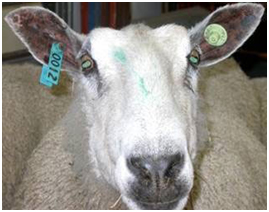

Tagging in goat & Different type of Tags
Disbudding and Dehorning
This should be done when the male kid is two to five days
old and the female kid is up to 12 days old. The hair
should be clipped from around the horn-bud, and this area
covered with petroleum jelly to protect it from caustic
soda or potash, which should be thoroughly rubbed on the
bud until the horn-bud is well blistered. Caustic soda
should not come into contact with the eyes. An electric
de homer can also be used safely. 'The kid should be
muzzled gently so that it can breathe freely; otherwise
partial suffocation may occur. Mature goats can be
dehorned by sawing off the horns close to the head with a
meat saw. This should be done in winter when flies are
not troublesome. The wound should be dressed.
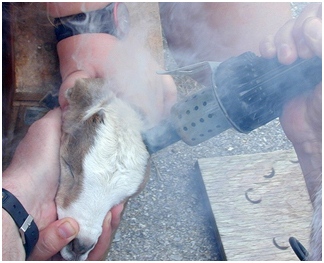
Disbudding
Castration
Male goats are raised mainly for meat and not for
breeding. For this reason males are castrated with an
emasculator, or torsion forceps. The best time for
castrating bucks is when they are six months old with the
Burdizzo instrument. This avoids all risks of infection.
Castration improves the flesh of the adult buck. A
castrated male is' called a wether.
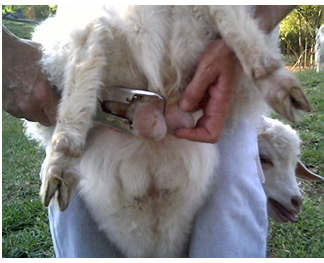
Castration
Exercise
The goats require exercise for maintaining themselves in
a good condition. Stock on range receives sufficient
exercise while grazing. Stall-fed goats should be let
loose in a large paddock for at least three to four hours
a day. The bigger the paddock, the better they enjoy.
Goats should not be let loose in the paddock or sent out
for grazing until the dew has dried up, i.e. not until
one to two hours after sunrise. Grazing on wet grass with
dew is likely to result in tympanites and intestinal
inflammation.
Hoof Trimming
Hoof trimming is necessary for the well-being of goats.
If neglected it can weaken legs, ruin feet and lower milk
production. The goats soon become used to trimming as a
monthly routine. Sharp pen-knives or curved hand-pruning
shears can be used effectively.
Selecting the Doe
An outstanding doe is the nucleus of a productive herd.
Selection of a doe should be made with great care. Good
body development is essential for high milk production.
The doe should be well grown, healthy in appearance, and
stand squarely on her feet and not down on the pastern.
The body should be wedge-shaped and sharp at the withers.
The depth of the ribs denotes capacity for consuming
large amounts of food. The thighs should provide plenty
of room for a round, well attached udder of fair size.

Doe
The skin should be loose, pliable and free from dryness.
Poor condition of flesh may be an indication of a good
milker, while a poor milker may be in good flesh. The
neck should be thin and the head narrow. The eyes should
be clear and bright. Does should be truly feminine in
appearance and mild in temperament. It is difficult to
handle, milk, feed and manage nervous goats. The milk
potential cannot be estimated from the size of the udder.
The udder of a good milch goat should be soft and pliable
rather than meaty. The teats should be pointed slightly
forward. The udder in a freshly milked goat should have a
collapsed appearance.
Selecting the Buck
The buck should have a strong, well-developed frame and
good conformation and breed characters. Good depth of
ribs is essential. Legs should be straight and well
placed under the body. The buck should be healthy and
free from external and internal parasites. He should be
chosen from a good milking strain and should be the
progeny of dams having good performance record. Poor
condition of flesh is not a serious drawback, since bucks
usually worry a good deal, especially during the rutting
season. Many herdsmen prefer the bucks to be hornless. A
well grown buck kid maybe bred to 'five or six does
during his first season at an approximate age of six
months. When 18 to 24 months old he may be permitted to
service 25 to 30 does, and when fully mature 50 to 60
does in a breeding season.

Buck
Mating Season
The does are more or less continuous breeders. The signs
of heat in the doe usually are uneasiness, tail shaking,
pink and swollen genitalia, frequent urination,
restlessness, bleating and a little mucous discharge for
one to three days. The period between heats varies from
18 to 21 days. It is better to inseminate the doe on the
second day of the heat period. The sperms survive in the
female genital tract for 22 to 42 hours. Mating should be
so timed that the kids are born in a season when
mortality among them is at its lowest and an adequate
amount of food is available for their nourishment and
growth. Breeding seasons will, therefore, vary with
breed, locality and climate.
Mating of the Doe
Does may be mated when 10 to 15 months old so that they
kid at the age of 15 to 20 months. But as a rule a goat
should not be mated until it is one year old. The
average gestation period is 151 ±3 days. It is better to
breed the female once a year. Some goats can be made to
kid twice in 18 months. The goats reach their maximum
efficiency at the age of five to seven years. In
exceptional cases they continue to be serviceable even up
to 12 years and in rare cases up to 14 years. A well
maintained doe may continue to be milked until a month
before she is expected to kid again. The condition of
the doe during gestation will have a very great influence
on the quality of kids at birth. A doe in good condition
will produce strong lively kids, whereas a doe in poor
condition may produce ungainly kids, weak in
constitution. Does must be fed well, allowed liberal
exercise and protected from rain and cold.
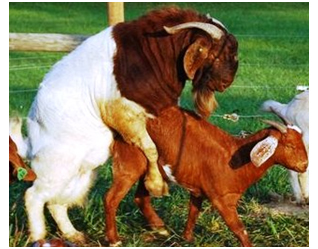
Mating
Goats in Kid
A temporary increase
in milk yield after mating is considered to be an
indication of pregnancy, but the first sign that a doe is
in kid is the cessation of the Periodical return of
oestrus. During the first three months of pregnancy there
is little alteration in the shape of the in-kid does. The
head of the kid can sometimes be felt from six to eight
weeks. An old doe or a young doe which is to give birth
to one kid may be very misleading in appearance and show
no sign of pregnancy. Six to eight weeks before kidding,
young does commence to show udder development, but this
is by no means a sure sign of pregnancy as they will
frequently show such development and even have milk in
the udder when they are not in kid.

Pregnant Doe
An average goat can rear well two kids. Goats are known
to give birth to as many as five kids at a time, but
birth of such large numbers affects the health of the
goat. The incidence of twinning varies with the breed,
environment and number of kidding. The Beetal goats at
Hisar Farm produced in a year, on an average, 35 per cent
singlet, 54 per cent twins, 6·3 per cent triplets and 0·4
per cent quadruplets. In Jamunapari the percentage of
twinning varies from 19 to 50 with an average of 35, and
in Barbari from 47 to 70.
Care of pregnant goat
1. Keep pregnant
animals separated from others
2. Provide adequate nutrition, easily digestible and
laxative diet
3. Do not allow them to fight with each other
4. Do not allow them to mix with recently aborted
animals
5. Shortly before the doe is due to freshen, clip hair
around the udder, hind quarters and tail for greater
cleanliness.
6. If the goat continuous to produce milk, dry her off at
least 6 to 8weeks before expected kidding.
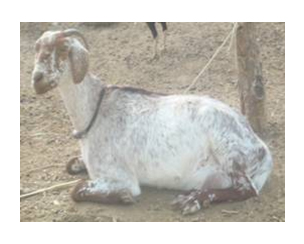
Care of newborn kids
Clean the nostrils and remove the placental membranes
sticking on the kid, by gently rubbing with dry cotton or
rags. Holding the kids up by hind legs with head downward
for few seconds, will aid in clearing the respiratory
tract. The kid will get up and start walking within half
an hour. Allow the doe to lick the kids dry. Immerse the
end portion of umbilical cord in tincture iodine. Repeat
this after 12 hours. The kid should get its first drink
of colostrum within 30 minutes of birth. If the kids do
not suck properly, the teats should be held by the hand
and pressed into their mouth. Once they have drawn a
little of the milk, it will not be long before they take
to the normal method of sucking.
-
Take care of newborn kids by providing guard rails.
-
Treat / disinfect the naval cord with tincture of
iodine as soon as it is cut with a sharp knife.
-
Protect the kids from extreme weather conditions,
particularly during the first two months.
-
Dehorn the kids during first two weeks of age.
-
Male kids should be castrated for better quality meat
production.
-
Vaccinate the kids as per the recommended schedule.
-
Wean the kids at the age of 8 weeks.
Proper selection of kids on the basis of initial body
weight and weaning weight should be initiated by
maintaining appropriate records for replacing the culled
adult stock as breeders.
Additional feed requirements of lactating does must be
ensured for proper nursing of all the piglets born.
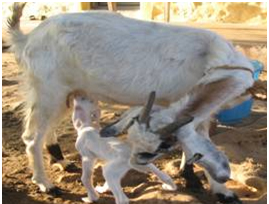
Care at milking
Keep the lactating doe away from the buck. Bruising of
the teats and udder of goats should be avoided. Generally
goats are milked twice a day. Prepare the goat for
milking by washing the udder with lukewarm water and keep
it dry with clothing. To prevent injury to the udder,
first close the thumb and first finger, then close the
second finger, followed by third finger. Use a steady
pressure. Finally close the little finger and squeeze
with the entire hand until the milk is drawn. Now release
the pressure on the teat and open the finger so that the
teat can refill. Repeat the process until very little
milk comes out. Both the hands can be simultaneously used
for milking.
Care of young Doe
They should be provided with good quality feed and
fodders. Stock for breeding purposes or in progeny-
testing programme should be weighed weekly and the weight
recorded in the register . Protect them against disease,
which can be effected by vaccinations.
Management of doe
The doe comes into heat every 18-24 days with an average
of 21 days. The duration of heat period 2 to 3 days. The
gestation period 151±3 days. Generally, the breeding
season is spread all over the year and under good feeding
and management conditions, two pregnancies in a year are
possible.
Reproductive Management
Doe
|
Age of attainment of puberty: |
7 months to 1 year |
|
Approximate weight at first mating: |
15-18 kg |
|
Age at first mating or insemination: |
8 months to 12 months |
|
Oestrous cycle : |
Generally every 18-21 days |
|
Duration of heat: |
14 ?48 hours |
|
Gestation period: |
145 ?156 days |
|
Age at first kidding: |
13 ?7 months |
|
Ideal kidding rate: |
3 in 2 consecutive years |
|
Service period : |
45 days |
|
Minimum dry period : |
30 days |
Signs of heat
-
Wagging of tail. The frequency of tail movement
increases in the presence of males.
-
Frequent bleating, more so when the goat is alone.
-
Excitement or restlessness.
-
Anorexia and lack of interest in feed.
-
Drop in milk yield.
-
Vulva becomes swollen and oedematous.
-
Small quantity of clear discharge from the vagina.
-
Doe anxiously goes seeking the buck.
-
It remains close to the buck and allows mounting.
-
It mounts on other goats and allows to be mounted by
others.
Gestation period
Symptoms at various stages of gestation in goats
|
Stage of gestation |
Cervix |
Vagina |
Uterus |
|
Non pregnant or before 25 days |
No tension of the wall |
Within pelvic cavity no hypertrophy |
Located within pelvic cavity, no clear asymmetry of
horns (slightly asymmetric in some of the does),
harder consistency. |
|
30 days |
-do- |
Within pelvic cavity |
Located at pelvic brim, clear asymmetry of horns
with softer and fluid filled consistency. |
|
45 days |
Slight stretching of the wall |
Located at pelvic brim, slightly hard in
consistency but no hypertrophy |
Located in front of the pelvic brim, complete
retroversion into the pelvic cavity possible. Clear
distension of uterus, softer in consistency, horns
distinguishable in some cases. |
|
60 days |
Stretched forward |
At pelvic brim, slightly hypertrophied and soft. |
Located in front of the pelvic brim, complete
retroversion possible in about 20% cases, marked
distension of uterus, fluid filled consistency,
uterine horns indistinguishable. |
|
90 days |
Stretched forward |
In front of pelvic brim, slightly hypertrophied and
softer. |
Uterus within abdominal cavity, only posterior
aspect of uterus palpable. Internal ballotment of
foetus possible in 80% of the cases, placentome
slip palpable in 30%. |
|
120 days |
Slight relaxation of vaginal stretching |
In front of pelvic brim, large and soft, difficult
to palpate in 20% cases |
Only posterior aspect of uterus palpable, internal
ballotment of foetus possible and placentome slip
palpable in all cases. Foetal parts and large
placentomes palpable in 90% of the animals. |
|
145 days |
Slight relaxation of vaginal stretching |
In front of pelvic brim, large and soft, difficult
to palpate in 20% cases. |
Foetal parts palpable within pelvic and placentomes
palpable in 85% of the animals. |
Artificial Insemination of Goats
Introduction
In goat production, this technique has been limited to
mostly dairy goat herds. However, meat goat producers
have shown interest in learning this technique to
accelerate genetic gain in their herds.
Advantages of AI
AI is the best way to spread elite genetic material
throughout a population. Semen can be collected from top
bucks, frozen, and then transported throughout the world
where it can be utilized by large populations to
facilitate progeny testing. Progeny testing involves
breeding offspring to determine their genetic merit.
AI helps producers to utilize their prize bucks that may
be physically injured and unable to mate.
AI allows producers to increase their herds without
purchasing and maintaining bucks or losing them to
predators, injury, or illness.
AI is effective in controlling diseases.
AI is an important breed preservation process.
Disadvantages of AI
The technician must be well trained in the anatomy,
function, and regulation of the doe reproductive tract to
manipulate the reproductive function and estrus
synchronization.
AI requires special equipment and facilities.
It requires a great deal of time to check heat that is
crucial for a successful process. On average, a doe's
heat phase lasts for 12 to 48 hours.
AI increases capacity to disseminate undesirable genes in
a population.
The Doe's Estrous Cycle
The doe's estrous cycle is the interval between two
estrus or heat periods that lasts an average of 21 days.
The estrus or heat can last from 12 to 48 hours. During
estrus does are receptive to being mounted by bucks. For
artificial insemination, it is important to identify when
a doe is in heat. Producers are encouraged to utilize
teasers, usually a vasectomized buck to identify a doe in
heat.
Steps to Conduct Intrauterine AI in Does with Frozen
Semen
Identify the doe in heat and certify the correct time for
AI.
For a better access to the doe's cervical os, place doe
in the stand, with the back legs up, raising its back and
leaving its front legs in support and its neck and head
toward the ground.
If needed, wash the doe's vulva with clean water to
remove any dirt, and dry the area with a clean paper
towel.
Introduce the vaginal speculum and be sure to check for
the appropriately-sized speculum. If needed, apply a
nonspermicidal lubricant or petroleum jelly to facilitate
the introduction of the speculum in the vagina. To
introduce the speculum, open the labia of the vulva with
one hand and with the other hand, gently introduce the
thinner extremity of the speculum. As soon as it is
introduced in the vagina, use a little pressure to orient
the speculum toward and down to the vaginal floor. Use
light source to visualize the cervical os. Be sure to
distinguish the cervical os from the pleats of the
vagina.
Examine mucus consistency and, if needed, remove
excessive vaginal mucus with the speculum.
If it is time for AI Determine which buck the doe
should be inseminated to before thawing the semen.
Thaw the semen. Prior to thawing the semen, use a
thermometer to check for water temperature (95 to 98° F)
before withdrawing the straw from the tank. Never lift a
canister above the frost line of the tank. When the straw
is removed with a forcep or tweezer from the tank it
should be placed immediately in the thaw bath.
Do not expose semen to direct sun light.
Do not refreeze semen that has been thawed.
Remove straw from the tank for periods as brief as 5
seconds. If you cannot remove the straw at the first
attempt, lower the caner back to the bottom of the tank
for at least 30 seconds before trying again. Stay out of
direct sunlight because ultraviolet light has a
spermicidal effect that will kill the sperm cells.
Rapidly deposit the straw in the thaw bath to protect it
from the sunlight.
Warm the barrel of the straw gun.
Dry the straw with a clean paper towel.
Cut the correct extremity of the straw or the opposite
side of the cotton plug.
Insert straw into gun; be sure to protect the straw from
the sunlight and extreme temperatures.
Place the plastic sheath over the gun barrel.
Return to the doe, introduce a clean vaginal speculum,
and remove excess mucus.
Introduce the gun into the vagina to the direction of the
cervical os, passing the gun through cervical rings until
it reaches the uterine lumen, the interior of the uterus.
If the operator encounters resistance in accessing the
interior of the uterus, deposit the semen in the exterior
of cervix, and make a note of this in your records.
Remove the gun speculum and leave the doe for a few
minutes in the standing position before releasing her.
Observe if reflux of the semen to the gun occurred.
If possible, use a microscope to check for semen left in
the straw. Check for sperm motility.
Release the doe from the AI stand gently. Record
information from empty straw before discarding.
(Source: Dr.Acharya, Handbook of Animal Husbandry;
Agritech portal TNAU;
www.vuatkerala.org ).
FEEDING MANAGEMENT
Classification of Goat Feed
Like the food of other domestic animals, goat feed should
contain proper amount of protein, fat, minerals and
vitamins. Goats usually drink less water than other
livestock animals. Always try to provide them fresh and
clean water. The types of goat feed are described below.
Roughage
These types of feed contain more than 18% fibre and less
than 60% total digestible nutrient. Roughage for goats is
of two types. Dry roughage and succulent roughage.
Succulent roughage contains 75-95% water. Grasses, maize,
Napier, jack fruit leaf, cabbage, vigna sinensis, pulse
etc. are the source of green roughage. Goats are
ruminants and they can take nutrition easily form
roughage feed.
Concentrate Feed
Grainy feed or feed mixer is easily
digestible and enriched with various types of nutritious
ingredients such as protein, carbohydrate and fat. This
type of goat feed contain less water and less than 18%
fiber. Total digestible nutrient is less than 60%. The
main sources of grainy goat feed are pulse, wheat, maize,
rice, gram, pea, triticum aestivus, potato etc. Besides
these, mustered cake, sesame cake, molasses, agricultural
byproducts etc. are also good as grainy goat feed source.
For making balanced and nutritious goat feed, you need to
mix different types of vitamins and minerals in the
grainy feed. Along with this, you can get more vitamins
and minerals from different types of vegetables. By
consuming roughage feed, your goats can only survive
their life. But for producing meat, milk, skin or fur
from goat commercially, you must have to feed them
different types of grainy feed along with
roughage/greens. Mix different types of ingredients in
the grainy goat feed. This will increase the taste of
food and goat can easily digest it.
Balanced Goat Feed
The food which contains all nutrient
ingredients in proper ratio and quantity to meet up the
demand of goat’s body is known as ‘balanced goat feed?
Every goat needs quality nutritious food for healthy live
and better production. If your goats do not get balanced
feed, then they will not get nutritious ingredients
according to their demand. And it will reduce their
production capability and damage their product’s quality.
Follow the chart of nutritious goat feed.
|
Feed
Ingredients |
Baby
Goat (%) |
Dairy
Goat (%) |
Meat
Goat (%) |
Pregnant
Goat (%) |
|
Gram |
20 |
15 |
20 |
50 |
|
Maize/Broken Wheat |
22 |
37 |
23 |
20 |
|
Sesame/Nut Cake |
35 |
25 |
30 |
20 |
|
Wheat Powder |
20 |
20 |
24 |
7 |
|
Minerals |
2.5 |
2.5 |
2.5 |
2.5 |
|
Salt |
0.5 |
0.5 |
0.5 |
0.5 |
|
Total |
100% |
100% |
100% |
100% |
In case of raising dairy goats, providing sufficient
amount of greens and water play a vital role. Along with
providing the goats nutritious food, ensure availability
of sufficient amount of greens. And provide them adequate
clean and fresh water according to their demand.
Feeding of breeding does
If the availability of pasture is good there is no need
to supplement concentrate mixture. In poor grazing
condition animals may be supplemented with concentrate
mixture @150 ?350 g of concentrate / animal/day
depending up on the age. The digestible crude protein
level of concentrate mixture used in the adult feed is 12
per cent.
Feeding does during the first four months of pregnancy:
Pregnant animals should be allowed in good quality
pasture 4-5 hours per day. Their ration must be
supplemented with available green fodder at the rate of 5
kg per head per day.
Feeding does during the last one month of pregnancy:
In this period fetal growth increases 60 ?80
per cent until parturition and lack of enough energy in
the feed can cause pregnancy toxaemia in does. So during
this period animals should be allowed in very good
quality pasture 4-5 hours per day.In addition to grazing,
animals should be fed with concentrate mixture @ 250 ?50
g/animal/day. Their ration should be supplemented with
available green fodder at the rate of 7 kg per head per
day.
Feeding does at kidding time
As kidding time approaches or immediately
after kidding the grain allowance should be reduced but
good quality dry roughage is fed free choice. It is
usually preferable to feed lightly on the day of
parturition, but allow plenty of clean, cool water. Soon
after kidding the doe must be given just enough of
slightly warm water. After parturition the ration of the
doe may be gradually increased so that she receives the
full ration in divided doses six to seven times in a day.
Bulky and laxative feedstuffs may be included in the
ration during the first few days. A mixture of wheat bran
and barely or oats or maize at 1: 1 proportion is
excellent.
Feeding lactating does
The following rations may be recommended
6-8 hours grazing + 10 kg cultivated green fodder/day
6-8 hours grazing + 400 g of concentrate mixture/day
6-8 hours grazing + 800 g of good quality legume hay/day
Feeding non pregnant does
If the availability of pasture is good no need to
supplement with concentrates mixture. In poor grazing
condition animals may be supplemented with 150 ?200 g of
concentrate / animal/day.
Feeding bucks for breeding
The common practice is allowing the bucks to graze with
does. Under such conditions the bucks will get the same
ration as the does. Usually, it will meet the nutritional
requirements of the buck. Where there are facilities for
separate feeding of the buck, it may be given half a
kilogram of a concentrate mixture consisting of three
parts oats or barley, one part maize and one part wheat
per day.
Feeding kids
Feeding from birth to three months of age
Immediately after birth feed the young ones with
colostrum. Up to 3 days of birth keep dam and young ones
together for 2-3 days for frequent access of milk. After
3 days and up to weaning feed the kids with milk at 2 to
3 times a day. At about 2 weeks of age the young ones
should be trained to eat green roughages. At one month of
age the young ones should be provided with the
concentrate mixture (Creep feed).
Colostrum feeding of kids
The kid should be allowed to suck its dam for the first
three or four days so that they can get good amount of
colostrum. Colostrum feeding is a main factor in limiting
kid losses. goatcolostrum is also efficient for kids.
Colostrum is given at the rate of 100 ml per kg live
weight. Colostrum can be preserved with 1-1.5% (vol/wt)
propionic acid or 0.1% formaldehyde. Propionic acid is
preferred for preservation as it keeps the pH value low.
The chemically treated colostrum is kept at cool place to
ensure better quality.
Creep feeding for kids
This creep feed may be started from one month of age and
up to 2-3 months of age. The main purpose of creep
feeding is to give more nutrients for their rapid growth.
The general quantity to be given to the kids is 50 ?100
gm/animal/day. This should contain 22 per cent protein.
Antibiotics like oxytetracycline or chlortetracycline may
be mixed at the rate of 15 to 25 mg/kg of feed.
Composition of ideal creep feed
Maize - 40%
Ground nut cake -30 %
Wheat bran ?10 %
Deoiled rice bran- 13 %
Molasses ?5%
Mineral mixture- 2%
Salt ?1% fortified with vitamins A, B2 and D3 and
antibiotic feed supplements.
Feeding schedule for a kid from birth to 90 days:
Age of kids Dam’smilk or goatmilk (ml) Creep
feed(gm) Forage, green/day (gm)
1-3 days Colostrum-300 ml, 3 feedings
- -
4-14days 350 ml, 3 feedings
-
-
15-30 days 350 ml, 3 feedings
A little A little
31-60 days 400 ml, 2 feedings
100-150 Free choice
61-90 days 200 ml, 2 feedings
200-250 Free choice
Feeding after three months to twelve months of age
Grazing in the pasture for about 8 hours per day.
Supplementation of concentrate mixture @ 100 ?200
g/animal/day with protein of 16-18 per cent. Dry fodder
during night in summer months and during rainy days.
Extensive Grazing
Grazing the sheep and goat in the entire pasture and
leaving them there for the whole season is the extensive
system of rearing. In this method feed cost is very much
reduced. It is not conducive to making the best use of
the whole grasses. So we can preferably practice the
rotational grazing method.
Rotational grazing method
Rotational grazing should be practiced under which the
pasture land should be divided by temporary fences into
several sections. The animals are then moved from one
section to another section. By the time the entire
pasture is grazed, the first section will have sufficient
grass cover to provide second grazing. Parasitic
infestations can be controlled to a great extent.
Further, it helps to provide quality fodder (immature)
for most part of the year. Under this system, it is
advisable to graze the lambs first on a section and then
bring in ewes to finish up the feed left by the
lambs.
Semi-intensive
Semi-intensive system of goat production is an
intermediate compromise between extensive and intensive
system followed in some flocks having limited grazing. It
involves extensive management but usually with controlled
grazing of fenced pasture. It consists of provision of
stall feeding, shelter at night under shed and 3 to 5
hour daily grazing and browsing on pasture and range. In
this method the feed cost somewhat increased. This system
has the advantage of Meeting the nutrient requirement
both from grazing and stall feeding. Managing medium to
large flock of 50 to 350 heads and above. Utilizing
cultivated forage during lean period. Harvesting good
crop of kids both for meat and milk. Making a profitable
gain due to less labour input.
Intensive system-zero grazing-system
It is a system in which goats are continuously kept under
housing in confinement with limited access to land or
otherwise so called zero grazing system of goat
production in which they are stall fed. It implies a
system where goats are not left to fend for themselves
with only minimum care. Intensive operation of medium
sized herd of 50 to 250 heads or more oriented towards
commercial milk production goes well with this system
particularly of dairy goats. It merits exploitation of
the system of feeding agro-industrial by products as on
pangola grass (Digitaria Decumbens) with carrying
capacity of 37 to 45 goats per hectare.
This system of management requires more labour and high
cash input. However, this has the advantage of close
supervision and control over the animals. In this method
the dung is collected in one place and used as a good
fertilizer. Less space is sufficient for more number of
animals.
Quality goat feed ensures quality meat or milk
production. Providing adequate feed according to the
demand of your goats help them to grow faster and produce
more milk or meat. Although goats always keep continue
searching for foods. Usually, they can go far from their
area for searching food. This type of food habit helps
them to meet up the nutritional demands. Naturally goats
are very hardy and can tolerate weather change highly.
They can survive for long time without water in heavy
drought. During natural disasters and food crisis, they
can even consume low quality food. This type of survival
with low quality food is not possible for other animals.
Their mouth are very strong among all the plant eating
animals. With their strong mouth, they can eat any types
of grasses, different types of leaves, branches of trees
etc. Goat converts food to quality meat or milk very fast
than other animal. Although goat can eat all types of
food, but they do not like to eat same food always. So,
they should have diversity in their regular feeding
habit. Goats usually do not eat leftovers of another
goat. They can understand the taste of food, but they are
not picky. Even they can eat and consume such food which
other animals don’t eat. But for commercial production,
you must have to very careful about goat feed. Always try
to feed your goats quality food with proper nutrition and
energy.
HEALTH MANAGEMENT
A
sound management program to keep animals healthy is basic
to production of both sheep and goats. Producers must
observe animals closely to keep individual animals and
the whole herd or flock healthy and productive. If the
heath status of a herd is compromised, that operation
will not be as efficient as possible. There are some
human health risks when dealing with diseased animals.
While most diseases affecting sheep and goats do not pose
any human health risks, some are zoonotic and it is
important to protect not only caretakers, but anyone else
that may come in contact with diseased animals. Sheep and
goats share many health problems.
Evaluating Animal
Health Status
To recognize clinical signs of diseases common to sheep
and goats, it is important to be familiar with what is
normal. Producers should assess the herd or flock’s
general health on a regular basis, including vital signs,
body condition, and coat. A normal temperature range for
sheep and goats is between 101.5°F and 103.5°F. The
respiration rate for sheep and goats is about 12 to 15
breaths per minute (depending on environmental
temperature), and heart rate should be between 70 and 80
beats per minute. Animals should exhibit a healthy hair
coat or fleece, while maintaining a body condition score
appropriate to their production stage. Both coat and body
condition score are good indications of nutritional
adequacy and overall health. Signs of an unhealthy animal
include isolation from the rest of the herd/flock,
abnormal eating habits, depression, scouring or diarrhea,
abnormal vocalization, teeth grinding, or any other
abnormal behavior.
Prevention of Disease
Biosecurity begins with the goal of preventing the spread
of infectious agents from infected to susceptible
animals. A bio security plan must take into account all
modes of transmission, including direct animal contact
within a herd, contact with wild animals or other
domesticated species, airborne transmission, contaminated
feed or water, and visitors or vehicles that come onto
the farm.
The most basic method of disease control in individual
herds/flocks is to avoid introduction of disease agents.
If possible and practical, producers should keep a closed
herd/flock. Most diseases of a contagious nature are
introduced into operations when new animals are added.
Disease agents can be introduced when breeding animals
are added to an operation; when animals co-mingle at a
fair, show or sale; or when animals contact wildlife. If
a closed herd/flock is not feasible, then use an animal
quarantine program. A useful isolation program consists
of a facility that prevents co-mingling of animals for at
least 30 days, including separate water supplies.
Advice and treatment from a veterinarian is almost an
absolute in preventing and controlling health problems in
a herd/flock. Veterinarians can recommend vaccination
programs; help with parasite control programs; assist
with reproductive management; deal with emergency
situations; prescribe drugs, do necropsies on dead
animals; and perform a host of other important management
tasks.
Examination for
Disease and Parasites
Purpose: Identification of animals in the early stages
of sickness can aid the farm manager in restricting the
spread of disease in the flock and initiating treatment
at the earliest.
Spotting of sick
animals
|
Sl.
no. |
Parameter |
Healthy animal |
Sick animal |
| |
|
1. |
Look of animal |
Alert |
Dull |
|
2. |
Head |
Raised |
Bent downwards |
|
3. |
Eyes |
Wide open, bright |
Dull with white deposition at the corners |
|
4. |
Conjunctival m.m. |
Normal |
Pale or congested |
|
5. |
Nose |
No discharge |
Slimy discharge |
|
6. |
Movement |
Active |
Sluggish, lameness |
|
7. |
Response |
Quick |
Slow |
|
8. |
Feces |
Normal |
Hard / loose, mucus/blood-stained, discolouration,
dysentry |
|
9. |
Pulse (/min) |
70-90 |
Increased |
|
10. |
Body temperature (oF) |
102.4 |
Increased |
|
11. |
Respiration (/min) |
12-30 |
Increased, difficult |
|
12. |
Grazing |
Normal |
Abnormal |
|
13. |
Rumination |
Regular |
Irregular |
|
14. |
Feed and water intake |
Normal |
Reduced |
|
15. |
Udder |
Normal |
May be swollen |
|
16. |
Skin |
Healthy |
Infected, external parasites |
Administration of
medicines
Routes include oral
(drenching/feeding bolus), parenteral (intra-muscular,
intra-venous, intra-peritoneal, sub-cutaneous) and
topical.
Common Diseases and
their Control
Morbidity
and mortality are the two important factors resulting in
heavy losses in sheep production and improvement
programmes. Prevention is always better than cure as it
is a lot cheaper. This has special significance with
sheep as they seem to respond less to treatment when sick
than other livestock species. Diseases in sheep can be
broadly classified as non-infectious and infectious.
(1) Pneumonia
It is one of the most
common and important pathological conditions in goat. It
is characterized clinically by increased respiration,
coughing and abdominal breathing. A toll of 20-40% of the
mortality has been reported at organized farms due to
pneumonia of bacterial or viral origin. Another type of
pneumonia is “aspiration?or “drenching?pneumonia caused
to wrong and forceful drenching operations. If some fluid
has erroneously entered the animal’s respiratory tract,
its head should be lowered immediately and slapped a few
times.
(2) Ruminal
tympany (Bloat)
It is the
over-distension of the left flank either due to free gas
or froth. This is generally encountered in “greedy
feeders?when lush green pasture is available. Tying a
bitter (eg. neem) stick in the mouth as a bit to increase
secretion of saliva is the most practical and can be done
immediately. Oral administration of sweet oil with
turpentine oil or at times with formalin is advised.
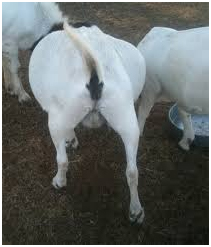
(3) Rumen
acidosis
Ingestion of large
amounts of highly fermentable carbohydrate feeds causes
an acute illness due to excess production of lactic acid
in the rumen. Clinically, the disease is manifested by
dehydration, blindness, recumbency, complete rumen stasis
and a high mortality rate. Normal saline, sodium
bicarbonate and antihistaminics are advised.
(4) Intussusception
It occurs commonly
due to nodular worms, change in feed and local intestinal
problems. The animal is dull, off-feed, kicking at the
belly with no rise of temperature, frequent straining
with no defaecation, colic symptoms, and at later stages,
recumbency. Emergency surgery is the only rational
treatment.
(5) Deficiency
diseases
1. Copper and
Cobalt: Characterized by anorexia and wasting. Growth and
wool production are severely retarded. Wool may be tender
or broken. Fine wool becomes limp and glossy and loses
crimp, developing straight, steely appearance. Anemia,
diarrhoea and unthriftiness occur in extreme cases.
Copper or cobalt sulphate treatment causes rapid
disappearance of the symptoms.
2. Calcium,
Phosphorous & Vit. D : The daily requirement of Ca, P &
Vit. D for an adult is about 2.5 gm, 1.5 gm and 300-500
units, respectively. Deficiency may result in rickets in
kids and osteomalacia in adults. Mineral supplementation
in diet is essential to prevent this deficiency.
3. Vitamin A:
Vit. A deficiency occurs in sheep on dry countryside
during periods of drought. Symptoms include night
blindness, corneal keratinization, ptyriasis, hoof
defects, loss of weight and infertility. Congenital
defects are common in the offspring of deficient dams.
Animals should have access to green pasture and should be
supplied with Vit. A in feed to prevent deficiency.
(6) Pregnancy
toxaemia (Ketosis)
It
is a highly fatal disease caused due to a decline in the
plane of nutrition and short periods of starvation (40
hrs) during the last two months of pregnancy.
Hypoglycaemia and hyperketonemia are the primary
metabolic disturbances. It is primarily a disease of
intensive farming systems. Symptoms include separation
from the flock, apparent blindness, constipation,
grinding of teeth, drowsiness, tremors of the head,
twitching of lips, in-coordination, ketonic breath,
leading to coma and death. Treatment comprises
intravenous administration of 50% glucose. Supply of
molasses in the ration and provision of additional
concentrate in the last two months of pregnancy helps
prevent the condition.
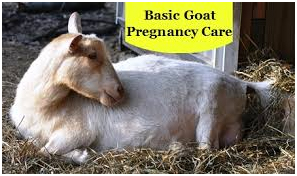
(7) Poisoning
i. Organochlorine
compounds : This group includes DDT, BHC, lindane, aldrin,
dieldrin, chlordane, toxaphane, methocychlor etc. which
are used as pesticides on crops and as ectoparasiticides
on sheep. Toxicity symptoms include increased
excitability and irritability followed by muscle tremors,
weakness, paralysis etc. Treatment consists of
administering antidote, usually short-acting
barbiturates.
ii. Organophosporous
compounds: This group consists of malathion, darathion,
chlorathion, carbophenothion, demton, dasnon,
dimethylparathion, trichlorphon, dioxalthion etc.
Symptoms of toxicity are profuse salivation, muscle
stiffness, dyspnoea with open mouth breathing, tremors.
Treatment consists of administering antidote, usually
atropine sulphate.
iii. Snake
bite: Sheep are usually bitten on the scrotum or udder.
The presence of hair may obscure the typical fang marks.
Prolonged pain, muscular weakness, impaired vision,
nausea and paralysis are generally exhibited along with
symptoms of shock. If anti-venin is not available and the
bite is located in an area where a tourniquet cannot be
applied, excision of an area of skin and sub-cutaneous
tissue can be life-saving.
(8) Wounds
During the monsoon
season, a large number of animals suffer from wounds at
various sites esp. around the ear, sternum and fore- and
hind-legs. The main reason seems to be the awns of Aristidia and Heteropogon species
of grasses, which initially break the continuity of the
skin, which is then attacked by flies making the wound
infected and maggoty. It causes great stress in young
lambs, and may also lead to conjunctivitis, corneal
opacity and blindness.
(9) Dystokia
The common causes are
insufficient opening of the cervical canal, heavy lambs
(esp. crossbreds), abnormal fetal position and uterine
torsion. The condition can be relieved surgically.
(10) Blackleg
It
is an acute, infectious disease caused by Clostridium
chauvoei and characterized by inflammation of
muscles, severe toxaemia and high mortality (approaching
100%). All age groups are susceptible. Increased protein
feeding of sheep/goat increases their susceptibility. The
spores are highly resistant to the environment and the
portal of entry is through the alimentary mucosa.
Infection in sheep generally takes place through skin
wounds following shearing and docking. Symptoms include
high fever, anorexia, discolouration of skin, crepitation
and depression. Penicillin is the drug o choice for
treatment.
(11) Enterotoxaemia (pulpy kidney)
It
is an acute disease of sheep/goat of all ages, but
primarily of young ones. It affects animals in a high
state of nutrition on a lush feed, grass or grain.
Morbidity rates seldom exceed 10% but mortality rate
approximates 100%. It is caused by Clostridium
perfringens type D which normally inhabits the
alimentary tract. Under certain conditions, the organism
proliferated rapidly in the intestines and produces
lethal quantity of toxin. In lambs, the course of illness
is very short, often less than 2 hours and never more
than 12 hours, and many are found dead without
manifesting early signs. Symptoms include green, pasty
diarrhea, staggering, recumbency, opisthotonus, and
acute, clonic convulsions with frothing at the mouth. A
history of sudden death of several big goats justifies a
tentative diagnosis of enterotoxaemia. Suphadimidine may
be effective for treatment. Two major control measures
include reduction in the feed intake and vaccination.
Infection with Cl. Perfringens type B (lamb
dysentery) and type C (struck, hemorrhagic
enterotoxaemia) result in severe enteritis with diarrhoea
and dysentery in goats.
(12) Tetanus
It
is an acute, infectious disease manifested by tonic
convulsions of the voluntary muscles. In goat, it
commonly follows routine operations such as castration
and even vaccination. Clostridium tetani form
spores which are capable of persisting in soil for a
number of years. The portal of entry is usually through
deep, puncture wounds. Symptoms include stiffness of
limbs, lock jaw, opisthotonus, followed by death due to
asphyxiation. Tetanus antitoxin is usually administered
but is of little value when the signs have appeared.
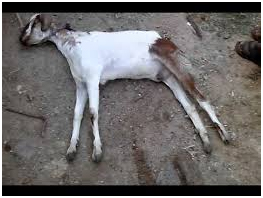
(13) Pasteurellosis
It
is primarily caused by Pasteurella haemolytica
and usually occurs in pneumonic form, although a
septicaemic form is not uncommon in lambs. Morbidity and
mortality rates may be as high as 40%. Transmission
occurs by the inhalation or ingestion of the infected
material. Symptoms include pyrexia, mucopurulent
discharge from the eyes and nose, coughing, depression
and anorexia. Preventive vaccination is recommended,
after which the animals should not be sent out for
grazing for 2-3 days.
(14) Paratuberculosis
(Johne’s disease)
It
is a chronic, wasting disease caused by Mycobacteirum
paratuberculosis and characterized by progressive
emaciation and a thickening and corrugation of the
intestinal wall. Mortality rate may be as high as 10%.
The disease causes severe economic losses in infected
flocks. As the progress of the disease is slow, it is
mostly seen in older animals. No treatment is successful.
(15) Goat pox
It
is a highly contagious viral disease characterized by
development of vesicles and pustules on the skin and
internal lesions. Spread may be by contact with infected
animals and contaminated articles, or by inhalation. It
often causes death in 50% of affected animals. Infection
of the pustules by secondary organisms may cause pyrexia
and other complications. The course of the disease is 3-4
weeks, during which time the goat becomes emaciated.
Vaccination is the best control.

(16) Foot and
mouth disease
It
is an extremely contagious, acute viral disease
characterized by development of vesicles in the oral
cavity and in the interdigital space. Mortality is
usually low (3%), but the economic loss is chiefly due to
the loss in condition of the affected animal.
Transmission is by contact with the diseased animal and
incubation period is less than 24 hrs. Antibiotics are
recommended to check secondary infections. Vaccination is
the best control.
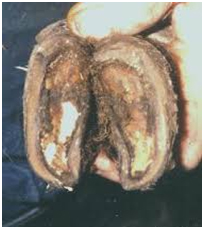


(17) Contagious
ecthyma
It
is a viral disease characterized by the formation of
papules and pustules and the piling up of thick crusts on
the lesions. The virus gains entry through unobserved
wounds on the lips. The incubation period is dependant on
the amount of virus introduced. The lesions are mostly
found on the commissures of the lips and are covered by
scabs. The course of the disease is 1-4 weeks.
Antibiotics are recommended to check secondary
infections.
(18) Blue tongue
It is an infectious
but non-contagious, exotic disease of sheep. Natural
transmission takes place through insect vectors viz. Culicoides and Aedes species,
and sheepked Melophagus ovinus. Incubation period
is less than a week. Pyrexia upto 106oF is the
common initial symptom.. The disease has three clinical
forms : abortive, acute and sub-acute. The abortive form
mostly goes unnoticed. In the acute form, there is fever
lasting for 5-6 days with nasal discharge, frothing,
marked salivation, highly congested and cyanotic nasal
and oral mucosa, epithelial excoriation in the oral
cavity and purplish discolouration of the interdigital
space, pasterns and coronets. Symptoms are less severe in
the sub-acute from. Morbidity rate may be 50% or more
whereas mortality rates very widely. Antibiotics are
recommended to check secondary infections.
Vaccination of
Sheep and Goats
Vaccinating the herd/flock can provide some insurance
against specific common diseases. However,
eachvaccination program must be tailored to an individual
operation. It is also important that producers understand
what they are vaccinating for and why it is important.
This is another instance where a veterinarian’s
assistance can be critical.
Just
because there is a vaccine available for a specific
disease does not mean producers should use it. There
should be economic or other justification to vaccinate
for specific diseases. Producers should work through the
risk factors and other control programs with a
veterinarian and decide whether or not it makes sense to
vaccinate.
The
clostridial vaccines are the only ones that can be
recommended on a blanket basis for almost all sheep and
goats. All other vaccination programs need to be
developed specific to a herd/flock. Sheep and goats
should be vaccinated for Clostridium perfringens
Types C and D and tetanus (CD&T) at appropriate times.
Combination vaccines (7- and 8-way) are also available
against other clostridial diseases, such as blackleg and
malignant edema. These vaccines are inexpensive, and
when used properly, are very effective in preventing
losses. Clostridial diseases are endemic to all sheep and
goat operations. They are caused by specific bacteria
that commonly live in the gut and manure of sheep and
goats and, under specific conditions, can affect both
sheep and goats. When handling vaccinations, it is
important to follow label directions, as vaccines must be
stored, handled, and administered properly. Only healthy
livestock should be vaccinated.
Vaccination schedule
for sheep:-
|
Disease |
Age and booster
doses |
Route |
Remarks |
|
Foot and mouth
disease |
6-8 weeks;
repeat every 6-9
months |
s/c or i/m
depending on the vaccine |
|
|
Hemorrhagic
Septicaemia |
3-4 months;
repeat annually |
1 ml s/c |
May/ June |
|
Sheep pox |
3 months |
s/c |
|
|
Tetanus |
Tetanus toxoid |
0.5 - 1 ml s/c or i/m |
|
|
Anthrax |
4-6 months; repeat
annually |
0.5 ml s/c at tail
fold |
In endemic areas
only |
|
Enterotoxaemia |
3-4 months, repeat
after 15 days and then annually. |
2.5 ml s/c |
First two doses
before august |
Vaccination schedule
for goats:-
|
Disease |
Age and booster
doses |
Route |
Remarks |
|
Foot and mouth
disease |
6-8 weeks,
repeat every 6-9
months |
s/c or i/m
depending on the vaccine |
|
|
Enterotoxaemia |
3-4 months, repeat
after 15 days and then annually. |
2.5 ml s/c |
First two doses
before august |
|
Hemorrhagic
Septicaemia |
3-4 months,, repeat
annually |
1ml s/c |
May/June |
|
Anthrax |
4-6 months, repeat
annually |
0.5 ml s/c at tail
fold |
In endemic areas
only |
|
Tetanus |
3-4 months, repeat
at 6 months and then annually |
0.5 - 1 ml s/c or i/m |
|
Internal and External
Parasites
Parasites pose a significant threat to the health of
small ruminants. Parasites can damage the
gastrointestinal tract, and result in reduced
reproductive performance, reduced growth rates; less
productive animals in terms of meat, fiber and milk; and
even death. General clinical signs that an animal is
suffering from a parasitic infestation include diarrhea,
weight loss or reduced weight gain, unthriftiness, loss
of appetite, and reduced reproductive performance.
Factors that may affect an individual’s susceptibility to
parasitism include natural genetic resistance, age, and
reproductive stage. Goats are generally more susceptible
to internal parasites than sheep. The groups most
susceptible to parasitism are young animals, lactating
ewes and does, and those in late gestation or around the
time of parturition. The animals least susceptible to
parasites are mature, dry ewes.
Internal Parasites.
Several types of
internal parasites affect sheep and goats, and all sheep
and goats have a low level of parasite activity. However,
excessively high parasite levels are often detrimental to
the health of the animal. The most common internal
parasite is the roundworm that lives in the abomasum and
small intestine of sheep and goats. There are several
types of roundworms that infect sheep and goats,
including Telodorsagia (Ostertagia)
circumcincta, Haemonchus contortus, and
Trichostrongylus colubriformis.
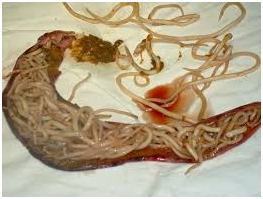
The
most dangerous parasite affecting sheep and goats is the
gastrointestinal roundworm Haemonchus contortus,
also known as the barber pole worm. This voracious
bloodsucking parasite has a tremendous capacity to
reproduce through egg-laying. Clinical signs include
anemia (pale mucous membranes), edema, protein loss, and
death. Animals suffering from Haemonchus contortus
become weak and lethargic, often straggling at the back
of the herd when driven a distance. Edema, or the
accumulation of fluid under the skin, is usually seen as
a swelling of the lower jaw, a condition known as bottle
jaw.
Tapeworms
can cause weight
loss, unthriftiness, and gastrointestinal upset. A
tapeworm infection can be diagnosed by yellowish-white
segments in the feces. Lambs and kids become resistant to
tapeworms quickly, so infections are most common in
animals younger than four or five months of age. The
biggest problem with tapeworms is that producers can
actually see the segments in fecal matter and can become
overly concerned. Infections by other internal parasites
are more serious than a mild tape worm infection.
Coccidia
are protozoan
parasites that damage the lining of the small intestine.
Since the small intestine is an important site of
nutrient absorption, coccidian can cause weight loss,
stunted growth, and diarrhea containing blood and mucous.
Other clinical signs include dehydration, fever, anemia,
and breaking of wool or hair. Fly strike and secondary
infections can also result from coccidiosis. Coccidia are
usually found in animals in confinement or intensive
grazing systems, as a result of poor sanitation,
overcrowding, and stress. Animals between one and six
months of age in feedlots or intensive grazing systems
are at highest risk for coccidiosis. Outbreaks of
coccidiosis can be controlled by implementing good
sanitation techniques, providing clean water, rotating
pastures, and avoiding overstocked pens. Outbreaks of
coccidiosis can be treated with sulfa drugs.
Coccidiostats can be administered to inhibit coccidial
reproduction.

Anthelmintics are drugs that either kill egg-laying
adults or kill larvae before they grow into adults and
become capable of laying eggs. An anthelmintic is
normally administered as an oral drench, a thick liquid
suspension deposited at the back of the animal’s tongue.
There are challenges associated with using anthelmintics,
since few are approved by the FDA for use in small
ruminants (although many are safe), and resistance to the
drugs can develop due to overuse and improper dosing.
Fecal Egg Count (FEC) Tests can be done to determine when
it is necessary to deworm, and to help determine the
level of pasture contamination.
A system known as FAMACHA has been developed to identify
those animals affected by Haemonchus that require
anthelmintic. In this method, producers observe the color
of the conjunctiva of the lower eyelid to determine the
level of anemia that an animal is experiencing. The goal
of FAMACHA is to delay resistance by only selectively
treating animals in a herd that are showing signs of a
parasitic infection. Sheep and goat producers should be
trained in the use of the FAMACHA system as it can reduce
the need for anthelmintic use and delay anthelmintic
resistance.
External parasites
may damage the
fleece and reduce pelt value. Parasites common to sheep
or goats include lice, keds, and mites. External
parasites are especially common in the winter when sheep
or goats are in closer confinement. Pour-on treatments
are a common form of management for many external
parasites, and are more effective on shorn sheep or
short-haired goats.
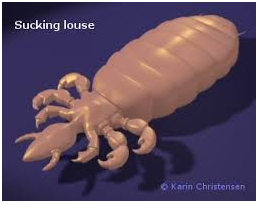

The many species of lice that parasitize sheep and goats
are generally divided into chewing lice and sucking lice.
Chewing lice feed from dead skin cells, while sucking
lice feed by sucking blood. Lice can be detected by the
presence of their eggs, called nits, which are not
susceptible to insecticides. Sheep or goats exhibiting
wool or hair loss should be checked for nits. Chewing
lice are eradicated with pour-on topical insecticides,
while sucking lice can be treated with specific
anthelmintics that control them. Keds pierce the skin and
suck blood, and are usually found on the neck, shoulders,
and flanks. Ked bites are very irritating to sheep,
causing them to scratch, rub, and bite themselves, which
damages the wool. Keds also cause wool discoloration,
which further reduces the value of the fleece. Ked bites
affect the hide quality as well. Shearing sheep will
remove most adult keds and larvae, and is especially
important before lambing. Further treatment with pour-on
insecticides after shearing or injection of Ivermectin
are both effective methods to wipe out a ked infestation.
Unlike lice and
keds, mites burrow beneath the skin instead of living on
the surface. This irritates the skin, causing the sheep
and goats to itch, which results in wool or hair loss and
lesions or scabs. Mange can be diagnosed by doing a skin
scraping. Administering injectable Ivermectin or topical
insecticides can help affected animals.
Source:https://sites.google.com/site/viveklpm/sheep-and-goat-production-management/diseases-of-sheep-and-goat
Dr. Vivek M. Patil, Assistant Professor, Department of
Livestock Production Management, Veterinary College
Bidar, Karnataka Veterinary, Animal & Fisheries Sciences
University, Post Box No. 6, Nandinagar, Bidar, INDIA -
585401. And Purdue University Cooperative Extension
Service, West Lafayette, IN 47907
